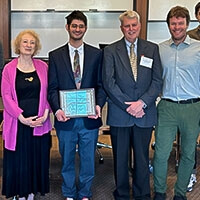An award-winning new article by Professor Steven Schaus suggests an alternative to the traditional understanding of tort claims for loss of consortium.
Schaus’ paper “Wrongs to Us,” published in the Michigan Law Review, argues that a consortium claim—a tort claim that one family member can bring when another is injured and the relationship suffers—could be considered as an injury to two people together, rather than simply as a collateral harm to someone who is related to the primary injured party.
The Association of American Law Schools honored Schaus, an assistant professor of law, with its Section on Jurisprudence 2024 Future Promise Award, “given annually to a pre-tenure-track or early tenure-track scholar whose work reflects future promise in both philosophy and law.”
“I’m surprised and very honored” by the award, Schaus said. “I’m very grateful to the people on the committee who found this paper interesting and promising enough to recognize it in this way. It’s a somewhat niche, speculative project. So it was very rewarding and heartening that it spoke to other people.”
Schaus recently answered five questions about the issues raised in his article:
1. How have loss of consortium claims traditionally been viewed?
These claims have been around in some form for 300 or 400 years. At the outset, the idea was that if a married woman was injured by another person’s carelessness or intentional wrongdoing, her husband would have a claim in addition to her own. The thought was that in wronging her, you wronged the husband, too; you deprived him of the services of his spouse.
Even as legislatures passed laws changing the status of women in the 19th century, this weird asymmetry in tort law persisted in the United States. Husbands could bring claims if their wives were injured, but wives couldn’t bring claims if their husbands were injured. This changed between the 1950s and 80s. And claims have expanded in other ways, too. In many states, parents can bring claims when their children are injured, and sometimes children can bring claims when their parents are injured. In just about every state, tort law now empowers people to sue and receive compensation when their loved ones are injured by another person’s tort.
2. How does your approach differ from this?
If you think tort law is primarily about vindicating the rights that plaintiffs have, then these claims can seem very puzzling. The puzzle is how to articulate what right is being asserted or what right has been infringed without falling back into a patriarchal way of thinking. If you injured someone’s wife or child, it might strike us as slightly off if they were to come to you and claim, “look what you did to me.” Yet we allow people to assert these claims every day.
The alternative I offer in this paper is to take seriously the idea that there’s a “consortium” that’s harmed in these cases. I focus mostly on couples in marriage-like relationships. When people are in committed relationships, they conceive of themselves as engaged in a kind of shared life project. If we take this idea seriously, then that provides us a way to think about the harm that might be done when one partner in this partnership is injured: That partner’s individual life and projects are derailed when they’re tortiously injured, of course, but in many cases, that means the partnership’s shared life and projects are derailed, too.
The view I offer is that—in light of how important these kinds of partnerships tend to be in our lives—partners have certain rights against interference with their shared projects, and tort law recognizes these rights by empowering people to bring claims for loss of consortium. When we bring consortium claims, in other words, we should understand the partner who sues to be saying, “Look what you did to us—interfering with my spouse’s life in this way, you’ve also interfered in the life that we were sharing.”
3. How did you get started down this path?
My interest in this project goes all the way back to my first year of law school. The case that got me interested in this was not actually a consortium case, but a case—Dillon v. Legg—on a related tort that we read in my first-year torts class. (That class was taught by my now colleague at Michigan Law, Alex Klass, who was visiting Harvard at the time!)
Dillon is a 1960s California Supreme Court case that’s been quite influential. In it, a mother was watching her two daughters play in front of their house, and one of the daughters was hit by someone carelessly driving and died. The question is, can the mother recover for her emotional distress?
The courts found this to be intuitively plausible—that someone in that position should be able to recover—but struggled to articulate why, because the mother herself wasn’t endangered by the careless driving. The California Supreme Court—and courts that followed it, especially—decided that the line between family and not-family is important in these cases; family members can recover, they said, whereas someone who’s unrelated to the victim but is still traumatized by what they see wouldn’t be able to recover. I thought that made a kind of sense—it seemed to me then (and now) like the family member is a victim of wrongdoing, rather than simply a victim of circumstance or misfortune—but I wasn’t sure I could articulate why. I pulled at that thread and it eventually led me here.
4. What are some of the broader implications of this article?
This paper is really about people in marriage-like relationships, but these claims have been recognized for parents whose children are injured and children whose parents are injured. So one set of questions is whether this idea of a shared project, a shared life, can be extended to this broader set of family-related claims.
More broadly, we are in close relationships with all kinds of people—friends, family members, spouses. or a functional equivalent. Keeping that facet of our lives in view and exploring the ways in which that complicates thinking about rights and what we owe to each other could be very fruitful.
5. Do you plan to continue pursuing this concept?
I think it’s fruitful to think about relationships involving shared projects and to think about the ways in which shared projects can be connected to sharing rights. I feel more confident in that basic outline of a solution, though, than I do in the very particular details of my solution. I’d like to make some progress on the details. More broadly, I am cautiously optimistic that other people will find the questions interesting too and will show me where I’m wrong in the details in order to help make this theory better. In some sense, that’s all one can hope for in this business.







